21 Sep OWASA’s Efforts to Prevent Lead from Entering Drinking Water
OWASA is proud to provide water, sewer, and reclaimed water services to customers across the Carrboro, Chapel Hill, southern Orange County community. OWASA met or surpassed all state and federal regulations during the latest regulatory period covering the 2021 calendar year.
UNC – Chapel Hill officials recently sampled several water fountains on the university campus that were known to have lead components. Some of these samples returned results showing detectable levels of lead that, in some cases, exceeded regulatory limits. OWASA will continue supporting UNC in their efforts to remediate these locations where lead was detected.
OWASA wants to assure the community that these results at UNC do not mean that lead is present in drinking water across the community.
We test for lead in our treated drinking water when it leaves the Jones Ferry Road Water Treatment Plant (WTP) and in samples collected from homes throughout our service area. OWASA has always been in full compliance with the Environmental Protection Agency’s Lead & Copper Rule (LCR).
For over 20 years, samples of drinking water leaving the WTP have tested below the detectable level for lead of 3 parts per billion (ppb).
In cities with older water systems, lead may be present in public water mains because lead was used many years ago as a pipe material, due to its easy pliability, ability to withstand corrosion, and near-universal availability. Some water systems used lead goosenecks, a small section of pipe, to connect the water main to the service line. OWASA’s water system has no known lead pipes, and OWASA looked for and removed all known lead goosenecks from our water system in the 1990s.
However, lead can still enter drinking water from corrosion of plumbing materials that contain lead like lead solder as well as components of some fittings and fixtures that contain lead.
According to the EPA, building age and plumbing installations/repairs may increase the risk of elevated lead levels in your drinking water if corrosion occurred in the plumbing materials. Factors to consider may include:
- Buildings older than 1930: Likely to contain lead pipes that can contaminate water quality.
- 1930 – 1986: Likely to contain lead solders used to join copper pipes together. Lead pipes are possible.
- 1986 – 2014: “Lead-free” solders used on plumbing joints, brass fixtures or plumbing components may have lead. Lead pipes are very unlikely.
- 2014 – Present: Even if “lead-free materials” were used in new construction and/or plumbing repairs, lead leaching may occur. Lead pipes are very unlikely.
OWASA treats drinking water to help prevent corrosion of these components. As part of our regulatory requirements, OWASA tests for lead in drinking water in 30 homes built from 1983 to 1985 that we have identified as having copper pipes with lead solder. In our regulatory monitoring since 2008, we have had only two samples with a measurable level of lead, and both results were below the regulatory limit.
A revised LCR went into effect in December 2021 that included new guidelines to reduce lead in drinking water. The compliance date for the new LCR is expected to be in 2024. To prepare for the implementation of the updated rule, OWASA has engaged with a consultant, CDM Smith, to help prepare us to comply with the revised rule.
One update in the new LCR is a lower detection limit, which means samples must be analyzed using a method that can measure lower levels of lead than before. In anticipation of this change, OWASA began testing all samples at the new threshold in 2020, including in our most recent regulatory sampling carried out from June to September 2020; all samples came back below this updated level of 1 ppb.
We also provide lead & copper testing of our drinking water at no charge when requested by a customer. Analysis is performed by an independent contract laboratory. Test results are reported in our annual Water Quality Report Card. To request a lead & copper test kit, please contact our laboratory staff at (919) 537-4228 or WTPLaboratory@owasa.org.
Protecting our community from lead is a responsibility we share with you. Our Water and Health webpage has additional information for reducing your risk to exposure to lead through drinking water. More information is also available in the 2021 Water Quality Report Card, available in English and Spanish.
If you would like to take additional steps to reduce the chances that lead can enter your drinking water, some of the steps recommended by the EPA are:
- Flushing your water lines: If you have been away from the house or have not used water in several hours, run the faucet for 30 seconds to one minute to bring in new water that has not been stagnant in pipes. The longer you’re away from home, the longer you should run the faucet to flush the lines.
- Maintenance: Regularly cleaning the aerator or faucet screen at the end of the faucet will help prevent collection of harmful materials in the screen. If you have installed a filter to remove lead or any other compounds, you must maintain that filter according to the manufacturer’s instructions, or you will risk accumulating high concentrations of the material you are attempting to filter out.
- Service Line: OWASA is responsible for maintaining the drinking water distribution system from the reservoirs through the treatment plant and the pipes leading to your meter. Once the water passes through the meter, your service line is what brings the water into your home, and that service line is the homeowner’s responsibility. You can contact a licensed plumber for any issues you are experiencing with your service line or for an evaluation of what type of material your service line is made of.
See graphic below from EPA on how lead can enter drinking water:




